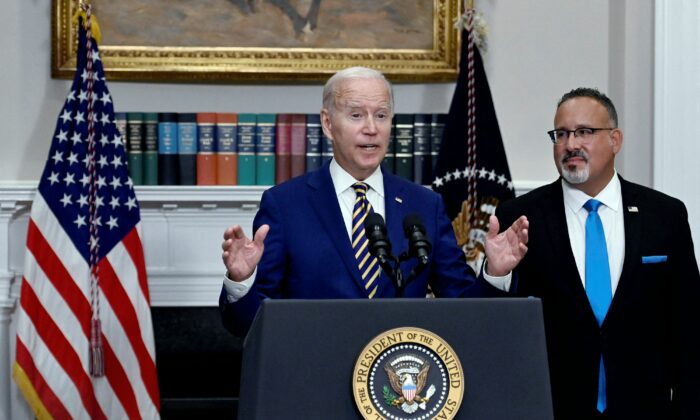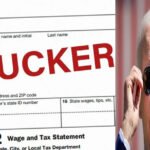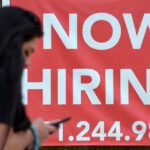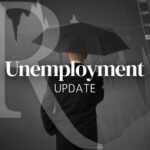By Michael Washburn
News Analysis
President Joe Biden’s ambitious plan to eliminate $10,000 of federal student debt, and $20,000 for those borrowers who received federal Pell Grants, will worsen the government’s roughly $30 trillion deficit while giving the incumbent party a justification to raise taxes steeply in the near future, economists who study the issue have told The Epoch Times.
Though often presented as an altruistic measure that will ease or wipe out the burden of indebtedness for those who had no choice but to borrow to fund their education and who now struggle with payments, the plan comes with significant moral hazard. It will foster reckless financial behavior and prove politically divisive as other categories of borrowers wonder why their own needs are considered secondary, the economists say.
Economic Factors
The administration’s claims that the plan is “paid for” because of anticipated changes to the size of the federal deficit this year are controversial and have met with skepticism even among former Democratic officials such as Lawrence Summers, who served as Secretary of the Treasury under President Bill Clinton.
Though praised by some grateful debtors and Democrat politicians, the question of the new measure’s feasibility, and who will pay for it and how, remains largely unanswered, some economists say. Opponents and supporters do not line up along partisan lines. The bipartisan consensus is that Biden’s plan is a tall order, believes Gary Wolfram, a professor of economics at Hillsdale College.
Even nonpartisan organizations with no animus against Biden have noted the exorbitant costs that will befall not only the wealthy but average taxpayers at the back end, Wolfram told The Epoch Times.
“This is going to cost taxpayers—the average person out there—about $500 billion, according to the Committee for a Responsible Federal Budget, which is a pretty middle-of-the-road group,” Wolfram said.
The committee, a Washington-based nonprofit research organization, has published an analysis determining that Biden’s plan will drive up the country’s already record-high inflation in the next year by 15 to 27 basis points.
“We’re going to have to pay this money, and we’re already running a deficit of $30 trillion, so that’s going to burden taxpayers and cause interest rates to increase. If you add $500 billion to federal government expenditures, you’re going to have to sell bonds or raise taxes,” Wolfram said.
Ivan Pongracic, a colleague of Wolfram’s in the Hillsdale economics department, noted that the Federal Reserve holds close to $6 trillion of the government’s nearly $31 trillion deficit. The Fed printed new money in order to buy roughly $3.5 trillion of the $6 trillion of bonds issued by the federal government during the pandemic, but further bond purchases are on hold until March 2023, he said. Consequently, the private sector and foreign governments will have to step into the breach and buy up Treasury bonds to alleviate the government’s debt, he said.
“It seems to me that the federal government is rushing headlong toward fiscal insolvency, and this act [student debt relief] will considerably accelerate that process, in addition to providing all sorts of distorted and perverse incentives,” Pongracic added.
Favoritism
Wolfram also noted basic questions of fairness that have gone unaddressed in many of the president’s official statements about the measure.
“What about the people who went to community college and worked full-time so they didn’t have to take out a loan? They’re going to have to pay taxes to pay for the forgiveness of a loan that some upper-middle-class student took out,” Wolfram said.
“And what about the people who paid back their loan? Everybody who paid it back should get a check for $10,000. That would be the rational thing to do,” he argued.
In an environment where debt takes so many forms, the moral and ethical issues are particularly acute. Biden has not explained why those who took out student loans are more deserving of a break than, say, all those citizens who struggle to make mortgage payments under the terms of their Federal Housing Administration loans, Wolfram said.
Currying Favor
Pongracic does not believe that the Biden administration has tried hard to put forth an economic rationale for the measure, which comes just weeks from the November midterm elections, in which heavy Democrat losses have been widely predicted.
“It is a blatant attempt to try to get more votes from the younger demographic, among which Biden has been dramatically losing support,” he said.
Though some have attempted to justify the measure on the grounds that it will help young people looking to buy their first home and start families, Pongracic said, it is not a foregone conclusion that student debt hampers them from doing so in the long term.
“It is well documented that individuals with college degrees uniformly have a substantially higher lifetime income than those without college degrees, making even the current highly inflated college tuitions economically justifiable (though less so each year),” he added.
In the view of Brian Domitrovic, an author and scholar of economic history who teaches at Sam Houston State University, Biden’s unveiling of his debt forgiveness plan must be seen in the context of the administration’s track record so far.
“Biden was having some problems with the left wing of his party. His administration has just had a string of incompetent actions and not getting anything done, and at least now he has some kind of achievement, however odd it is as policy,” Domitrovic said.
The fiscal policy of the Democrats has long been characterized as “tax and spend,” or in other words, amassing significant capital through heavy taxation and then putting it to use on an array of expensive social policies and programs. With his student debt plan, Biden has inverted this familiar model, developing a plan to “spend and tax,” or incur ever heavier fiscal obligations and then alleviate them through tax increases that were not included in the original plan but come to appear necessary to keep pace with federal profligacy, Domitrovic said.
Old Goals
According to Domitrovic, some Democrats had learned to live with the relatively low income tax rates achieved during the presidency of Ronald Reagan, but many of them pined for a way to put spending programs in place that would make modest levels of taxation impossible to sustain.
Long frustrated by resistance to higher taxes and the political difficulty of pushing their agenda through, Democrats may at last have found a means of driving up federal indebtedness so high that a marginal personal income tax rate in the 30 percent range and a corporate rate in the 20 percent range are not viable, Domitrovic said.
“The old direction used to be tax and spend, so this would be a new direction, spend and tax. But the 40 percent marginal increased tax rate has not been punctured since 1985, and President Clinton ended up with 39.6 percent, which is about the average of the rates under Reagan. In all the years since, including the Obama years, they never did a thing to raise that tax rate, so I think now they’re developing a new strategy and a new cover for raising taxes on the rich,” Domitrovic said.
This inversion of the familiar “tax and spend” motif, in fact, has ample precedent in U.S. history, he added, pointing to the administration of Lyndon B. Johnson in the 1960s. After having temporarily made his peace with the tax cuts enacted by his predecessor, John F. Kennedy, Jr., under whom Johnson served as vice president, Johnson aggressively pursued his Great Society social programs and escalation of the Vietnam War and attempted to ease the massive fiscal burden of these undertakings with an increased tax surcharge in 1968, Domitrovic said.
Domitrovic also alluded to the programs of President Franklin Delano Roosevelt, who made use of a tax increase in 1936 to pay for the unprecedented federal largesse of the various projects comprising the New Deal.
“There’s no greater icon, in the Democrat mindset, than FDR. He was not ‘tax and spend,’ he was ‘spend and tax,’” Domitrovic said.
Long-Term Issues
Other economists question the efficacy of a short-term measure, when education will continue to be highly expensive for so many people and the bankruptcy laws are peculiarly unfavorable to those facing insolvency over student loan debt as opposed to other kinds of obligations.
“It’s a complicated issue. My preference, in terms of policy to address student loan debt, is to deal with the cost of higher education directly, rather than to have, basically, a one-time debt forgiveness program,” Steven Peterson, a professor of economics at the University of Idaho, told The Epoch Times.
Peterson does not agree that the current high cost of education is justifiable. By way of comparison, Peterson recalled the costs that were typical when he enrolled at the University of Idaho as an undergraduate in 1975.
“Nominal in-state tuition was $215 per semester in 1975. In 2021, it would have been $1,083 if tuition had only increased at the rate of inflation (CPI). Current in-state tuition is $4,198 per semester,” Peterson said.
“Across the nation, people even 30 years ago were paying ten percent of what an institution today would cost a student, even allowing for inflation. The cost has risen in absolute terms, and it’s been rising far faster than inflation,” he added.
Unfortunately, those who struggle to stay afloat amid deep debt may find little protection available from the kinds of legal mechanisms to which other classes of debtors resort.
“In recent years, student loans have been largely excluded from the bankruptcy laws. If you have business loans or run up credit-card debt, you can file for bankruptcy, but it’s very difficult if you have student debt,” Peterson added.
Peterson said he understands the rationale that existed in the past for ensuring that students who went on to become doctors with huge salaries—for example—would not abuse federal loan programs to the disadvantage of the genuinely needy. But the reality now is that students or former students who are in serious trouble may not get bankruptcy protection under existing laws.
Besides changing the laws to have cases vetted individually through the courts, and outcomes decided on a case-by-case basis, Peterson said he would like to see greater support for state colleges and universities. In his view, such institutions have gotten short shrift as the federal government has leaned on states to handle Medicaid responsibilities.
“The increase in Medicaid spending has squeezed a lot of the funding available for higher education. It has been declining for many decades. I would like to see the federal government take more responsibility for Medicaid and the states step up and increase their funding for education,” Peterson said.
As much as he sympathizes with those who have struggled to pay their way through higher education and have come out of it saddled with debt, Peterson agrees with Domitrovic, Wolfram, and Petrovic about the dangers of arbitrarily canceling debt.
“Moral hazard is definitely there. One has to be very cautious about the law of unintended consequences. You can end up inadvertently encouraging people to take on debt,” he said.






